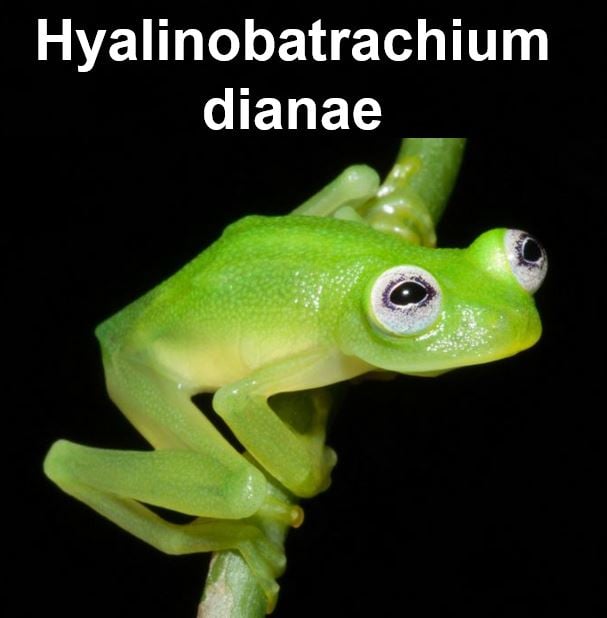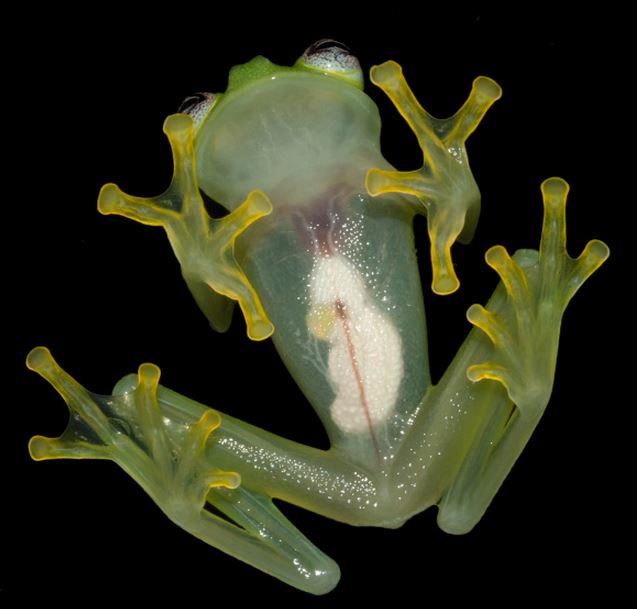A new species of Glass Frog has been discovered in the Talamanca Mountains of Costa Rica. Known scientifically as Hyalinobatrachium dianae, the frog is transparent – from the underside you can see its internal organs, including the heart, liver, and gastrointestinal tract, with the naked eye.
In February, the new species made its debut in the online library for taxonomic journals Biotaxa (Zootaxa – citation below).
With their hallmark lack of pigmentation on their skin, Glass Frogs are found in parts of Central America and South America.

The new species of Glass frog – Hyalinobatrachium dianae – sounds more like an insect when making its advertisement call. (Image: Courtesy of Brian Kubicki)
Herpetologists (amphibian and reptile specialists) are not sure why Glass Frogs are see through. Some suggest their translucence provides camouflage, either protecting them against predators or making it easier to catch prey.
There are 149 species of glass frogs known to scientists, fourteen of which can be found in Costa Rica.
Named after discoverer’s mother
Hyalinobatrachium dianae is the first new discovery of a glass frog in Costa Rica since 1973. Brian Kubicki, who works at the Costa Rican Amphibian Research Center, discovered the new species and named it after his mother, Janet Diana Kubicki.
Lead author Kubicki and colleagues Stanley Salazar and Robert Puschendorf found six specimens of the new species in the higher elevations of the Talamanca Mountains in the western provinces of Limón and Heredia.
The 2.5-centimetre-long amphibian has bright black and white eyes, and very long and thin feet.
Unique advertisement call
Most of H. dianae’s features are very similar to those of its cousins, except for its unique call.
Tico Times quoted Kubicki, who said:
“It’s advertisement call is quite unique. It’s different than any other species that has been discovered.”

From H. dianae’s underside you can see its internal organs. (Image: Courtesy of Brian Kubicki)
Male frogs call out in their attempt to attract females. H. dianae’s call consists of a long metallic-sounding whistle with a series of rapid pulses.
Kubicki says it sounds more like calls made by insects, which may be one of the reasons the elusive species took so long to be discovered.
Kubicki, who was surprised he would ever find a new glass frog species in Costa Rica, added:
“Costa Rica is a very well-studied area by herpetologists so this discovery was surprising.”
“We just needed some fieldwork in these areas that were poorly explored.”
This is the second discovery Kubicki and Salazar have made this year. In March, they wrote about their discovery of the first three Costa Rican fringe-limbed treefrogs in the journal Mesoamerican Herpetology.
Citation: “A new species of glassfrog, genus Hyalinobatrachium (Anura: Centrolenidae), from the Caribbean foothills of Costa Rica,” Brian Kubicki, Stanley Salazar and Robert Puschendorf. Zootaxa. February 2015. DOI: 10.11646/zootaxa.3920.1.4.
BBC Video – New Glass Frog species
